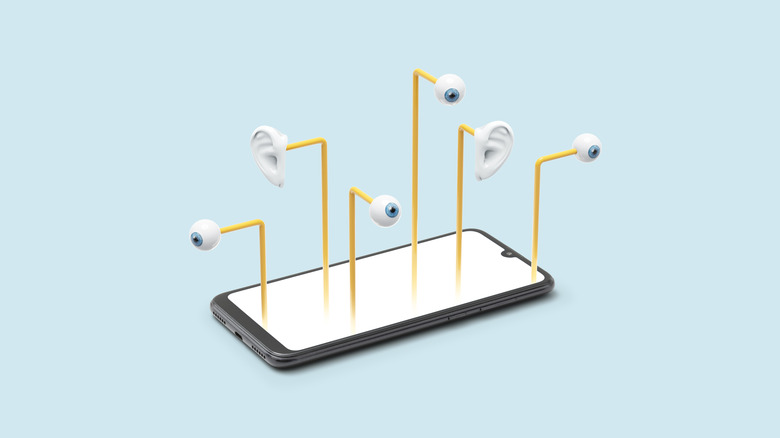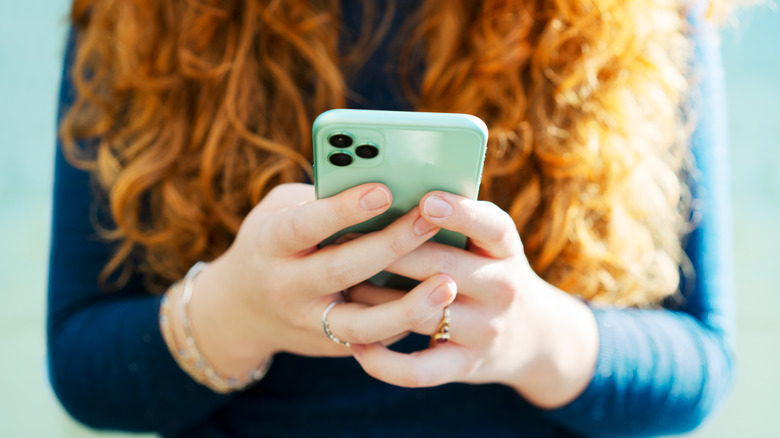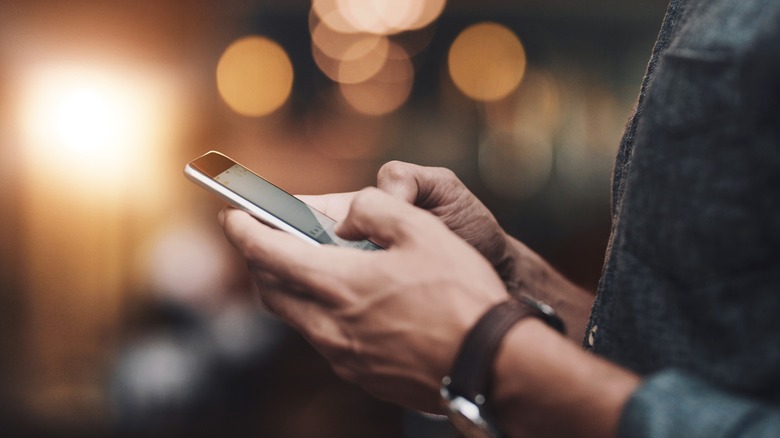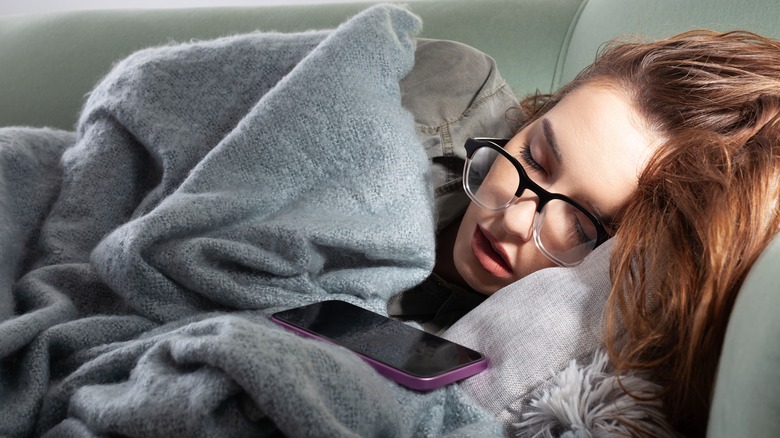4 Surprising Ways Your Phone Can Track You (Hint: It's Not Your Microphone Or Camera)
Most people have probably wondered at some point whether their smartphone is spying on them. You may have mentioned the name of an obscure product to a friend, only to see ads for it on your way home. Or maybe you've started seeing ads for digestive aids after having a stomachache. These types of experiences might have you second-guessing your phone's real purpose. It might be a window to the world, but if you can look out that window, who else can look in?
The good news is that, outside of the highly unlikely event when you've been the victim of advanced spyware, your camera and microphone aren't watching and listening to you without your consent. Not only would relying on audiovisual information be incredibly power-intensive, draining your phone's battery at an alarming pace, but it would also be inaccurate. Think about how often your phone's smart assistant mishears you when you're talking right to it, then consider how much worse the results would be when it's broadcasting from inside your pocket. Moreover, you probably don't say your thoughts aloud nearly as often as you convey them through other behaviors.
What's much more terrifying or fascinating, depending on how you look at it, are the ways your phone can actually track you. Its various sensors and interaction surfaces are like raw nerve endings for a multi-trillion-dollar data collection industry, and that industry has been unrelenting in its search for new and innovative ways to predict your behavior and shape your desires. Here are four surprising ways your phone is tracking you, even without using your camera or microphone.
The way you use an app tells it more than you think
Does it feel to you like apps are all becoming more alike? Instagram is hardly distinguishable from TikTok, and YouTube has incorporated a TikTok clone into its platform. What's happening is that every major web company has learned to optimize its platform to learn as much as possible about you based on the way you interact with it.
There's no clearer example of this than TikTok. It's popular because of its ability to learn what types of content you like and provide an unlimited supply of content in that vein, as well as a hefty dose of targeted ads. Almost everything you do in the app is tracked, from how long you linger on a video before scrolling (regardless of whether you left a like on it) to where on the screen you tap. While it's impossible to say with certainty which apps are tracking which behaviors, you can be sure that many of the apps you use day-to-day are paying attention to nearly everything you do (and don't do) while using them.
The way you interact with apps can even tell them how familiar you are with smartphone app design paradigms, and this heuristic inference was discovered by researchers as early as 1990. A digital native will zip around the app at lightning speed, demonstrating intimate familiarity with every aspect of the interface. Meanwhile, someone with limited computer literacy will tap more slowly, searching and hesitating in their interactions. A good app developer will use this information to make the app more intuitive for low-literacy users without disrupting the workflow of a power user. Of course, this information is also used to nudge users toward certain behaviors based on the developer's goals.
Wireless networks are a treasure trove for trackers
Every moment your phone is turned on, it's putting out digital feelers to analyze the wireless signals around you, including cellular and 5G, Wi-Fi, Bluetooth, and GPS. Of course, you need those connections to make calls, use the internet, connect to your earbuds, or navigate. But what you may not realize is that your phone isn't only looking at the networks you are connected to, but also the ones you aren't. That may seem trivial, but it's one of the most robust sources of tracking data you produce.
This data isn't just useful to the companies whose apps you use. Many are selling your data to make extra money, and in turn, that data has been purchased by the FBI for legally dubious purposes, as The Wall Street Journal discovered in 2023. It can potentially be used to compromise national security, including revealing the locations of nuclear sites, as WIRED discovered in 2024. In another case, The Wall Street Journal found that an anti-abortion group purchased geolocation data to send targeted misinformation to women who had visited Planned Parenthood clinics.
Like most privacy conundrums, wireless scanning is a double-edged sword for users. Wi-Fi and Bluetooth scanning are smartphone settings that could be worth turning off, but certain features will stop working. Turn off your wireless networks entirely, and you won't be able to access any web-connected apps or Bluetooth devices. At the very least, it's worth ensuring that the apps you allow to utilize these features actually require them to provide you with useful features, and aren't simply trying to extract a little extra data from your device for no reason.
The way you type reveals more than you think
Have you ever typed a comment on a social media post, only to delete it at the last second? The person you almost started an argument with will never know, but the app you're using might. In general, your keystroke dynamics (how you type) and linguistic style (what you type) reveal far more about you than you might think. The slang you use identifies the communities you're a part of (for instance, people from the Midwest tend to call soda "pop"). People who type quickly while making mistakes might be in a heightened state of anger or frustration. Those who type slowly and hesitantly could be nervous. Your overarching personality based on the "big five" model can also be inferred with limited accuracy.
Like any other data, keystroke dynamics can be used for legitimate purposes. For instance, it can be used for account authentication to make sure a human is typing in a password field rather than a hacker running an attack script. However, it could theoretically be used to target ads for alcohol to people determined to be depressed, or guide people in key swing districts for an election who are frustrated with politics toward extreme rhetoric. Those are just examples, but they're easily accomplishable with this type of tracking.
Your phone knows when you're sleeping, it knows when you're awake
Unfortunately, although your phone can tell when you're sleeping, it is not Santa Claus. Smartphones can infer your sleep habits with relative ease by tracking device activity and movement. That's why health tracking apps don't require wearables such as smartwatches to track your sleep. Your phone's existing sensors are more than enough to gain a decent estimate of the time you spend catching Zs.
The most obvious heuristic for tracking your slumber is your activity. Most people check their phones all day long, with the average user unlocking their iPhone or Android device 205 times per day, according to a Reviews.org survey based on 1,000 American adult respondents. If you suddenly stop checking your notifications in the evening and don't open your phone for eight hours, it's not rocket science to conclude you were sleeping.
There are other data points as well, including information from your phone's accelerometer. That's your phone's motion and orientation sensor, which is used to rotate your screen when you turn the device sideways or wake the display when you pick it up from your desk. If your phone doesn't sense motion for a while, that's another indicator of sleep. But if you're the sort of person who keeps your phone in bed with you rather than placing it on a nightstand, things get even more fascinating. When we sleep, we move, and your phone can sense that movement as if it were a partner lying in bed beside you. Unlike your partner, though, the best sleep tracker apps on your phone understand which movements correspond to which stages of sleep, and can use that information to figure out which stage of sleep you're in.




